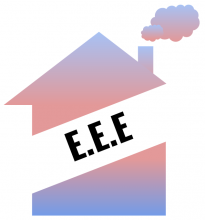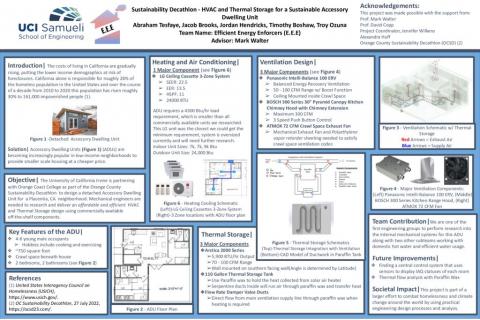Sustainability Decathlon - HVAC and Thermal Storage for a Sustainable ADU
Background
As engineers we are ingrained to design in order to solve problems, whether it be refining a small home appliance, prototyping a semi-autonomous robot, or constructing a building. While smaller scale feats can be impressive, some tend to forget that massive efforts are being made by engineers and scientists alike to combat global issues affecting communities around the world. One of these battles closer to home is the housing crisis and subsequent rising homelessness rates. In California alone, the homeless numbers have risen from roughly 123,000 in 2010 to 161,000 a decade later in 2020, accounting for roughly 28% of the total homeless population in the United States (USICH). These increasing homelessness rates have no sign of stopping any time soon, especially as the price of living in California continues to become more expensive to the average resident. Luckily, engineers across multiple disciplines have teamed together to counter these rising costs by developing small affordable units capable of housing the lower-income demographics.
A collection of Accessory Dwelling Units (ADUs) are being constructed to compete in the Orange County Sustainability Decathlon competition, showcasing various wallet-friendly, sustainable, and efficient housing designs. This competition, sponsored by California government agencies, is hoping to be a pioneer in a movement that will “lead the state’s transition to 100% renewable energy” (OCSD). The focus group of this team will be the HVAC system for our university ADU design. It should be adaptable to various climates, capable of providing heat in the winter and cold in the summer. Proper ventilation should also be considered in conjunction with the heating and cooling system to ensure safe air quality and thermal regulation. Lastly, a thermal storage system will be considered, and if feasible, should better help to preserve energy in the form of heat that drives these systems. The larger movement encompassing this project will not only help put more people in shelters, but should also inspire other counties in California, other states in the country, and other countries on the planet to host their own efforts against the global poverty crisis.
Goals and Objectives
By the end of the project, a critical design for each subsystem: heating and cooling, ventilation, and thermal storage, will be delivered to our collegiate team along with a Bill of Materials. The advocated systems of choice should be the end product of an extensive engineering design process involving research, established objectives and requirements, concept generation, proof of concept and system selection, implementation of prototype systems, and a finalized critical design.
- Weeks 1-2: Background & Preliminary Research
- Week 3: Concept Generation & Proof of Concepts
- Week 4: System Selection/ Preliminary Designs
- Weeks 5-6: Implementation (Prototyping) of Preliminary Design
- Week 7: Detailed Final Design for each system
- Weeks 8-10: Creation of Bill of Materials & Engineering Drawings
Team Name
Our group name is the Efficient Energy Enforcers (E.E.E) and the acronym can be seen in our team logo. This project is centered around sustainable housing through affordable and efficient means. As engineers, we can contribute to this mission statement by ensuring that the internal mechanical systems of the ADU have optimal energy efficiencies. It is important to make sure that these systems are cost-effective. They must consume as little power as possible, and energy they do require should be renewable and recoverable.
Midterm Presentation Slides
Midterm Presentation (HVAC) - Google Slides
Final Presentation Slides
Final Presentation (HVAC) - Google Slides
Team Contacts
Abraham Tesfaye - tesfayea@uci.edu
Jordan Hendricks - jphendr1@uci.edu
Jacob Brooks - jacobcb@uci.edu
Timothy Boshaw - tboshaw@uci.edu
Troy Ozuna - ozunat@uci.edu
Sponsor/Advisor
Mark Walter - m.walter@uci.edu


